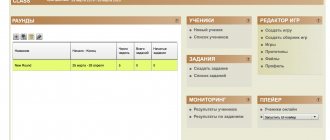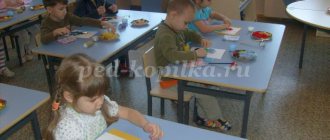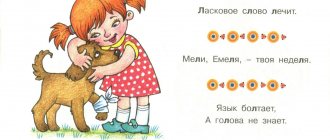Game technologies in teaching storytelling (middle age)
Galina Osipova
Game technologies in teaching storytelling (middle age)
Talk about what is shown in the picture, about your favorite toy, about your impressions of what you saw or heard - it seems that it could not be simpler? However, both kindergarten teachers and primary school teachers note that children experience significant difficulties when composing different types of stories . What is the reason for this?
Firstly, perhaps teachers do not pay enough attention to preparing children for writing stories examine the subject or picture well enough
Secondly, an analysis of children's stories shows that they experience difficulties in the ability to convey the proposed content logically, consistently, and interestingly.
Thirdly, stories show a lack of vocabulary, some speech stereotyping, stereotypes, and the use of repeated speech cliches.
Fourthly, in teaching children to tell stories , there may be no necessary system, and a variety of techniques and technologies .
In play, the child feels free and acts without constraint. Games arouse children's interest in activities, enrich the motives of speech, create a positive emotional background of the learning and thereby increase children's speech activity and the result of the lesson. The use of gaming technologies in the process of teaching children storytelling will be an effective means provided :
— adherence to the principle of developmental education ;
— consistent complication of the content of children’s education ;
— an integrated approach to the development of children’s speech;
— a personal and individual approach to teaching children .
The concept of “ game pedagogical technologies ”
includes a fairly extensive group of methods and techniques for organizing the pedagogical process in the form of various pedagogical games.
Unlike games in general, a pedagogical game has an essential feature - a clearly defined learning and corresponding results that can be justified, identified explicitly and characterized by an educational-cognitive orientation. The game form of the lesson is created with the help of game techniques and situations , which act as a means of inducing and stimulating children to learn.
Gaming technology is built as a holistic education, covering a certain part of the educational process and united by common content, plot, and character.
In our work to develop children's storytelling , we used games and activities such as:
1. Lesson - didactic game.
2. Lesson - role-playing game.
3. Activity - a game of travel.
All classes were united by the plot of the fairy tale “Winter House”.
The work began with learning to retell a fairy tale . The following was introduced into this lesson:
— game character,
- included didactic games: “Find the hero of the fairy tale”
,
“Correct the mistake”
- didactic exercise “ Tell a fairy tale in a chain ”
.
The use of a variety of gaming techniques in the lesson allowed the children to practice monologue statements and retell the text in various ways in a form that was interesting to them.
At the next lesson, children were taught to write a descriptive story about a toy . The lessons included:
1. Didactic game “Bring a toy - the hero of the fairy tale “Zimovie”
»
2. Joint description of the toy
3. Game exercise “Right - Wrong”
.
Various game techniques were used when compiling a story based on the picture : the didactic game “Correct the mistake”
(find a pair for the cub,
examined the picture , carried out a game exercise with a ball “What a cat can do”
, together made up
a story based on the picture .
As a means of consolidating “Journey to a Fairy Tale" was played »
.
During the lesson, the didactic game "Wonderful Bag"
a game character was introduced (the hero of the fairy tale "Zimovye"
,
looked at illustrations for the fairy tale "Wintermovie"
, used
the game exercise "Letters from a Good Storyteller"
, and then visited the forest where the heroes of the fairy tale live
" Winter "
remembered and
told a fairy tale .
In the work they used not only group, but also individual work techniques. In individual work they used didactic games: “It happens or not”
,
“Toy Store”
,
“Meeting with Dunno”
,
“Who Got Lost”
.
In all these games they also tried to introduce characters from the same fairy tale. Thus, we solved
teaching children storytelling Using didactic games, role-playing games, and travel games, we helped children acquire knowledge about the structure of the text; the ability to describe an object, a toy; reason logically , explain, prove, generalize. The level of monologue speech skills has increased significantly. The gaming technology we developed has shown good results.





